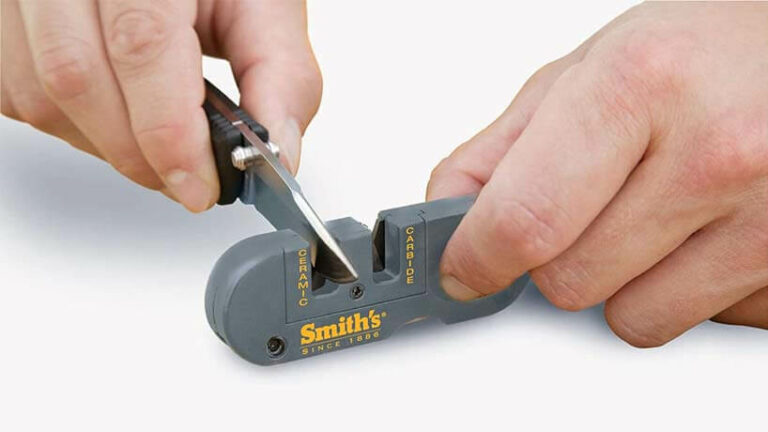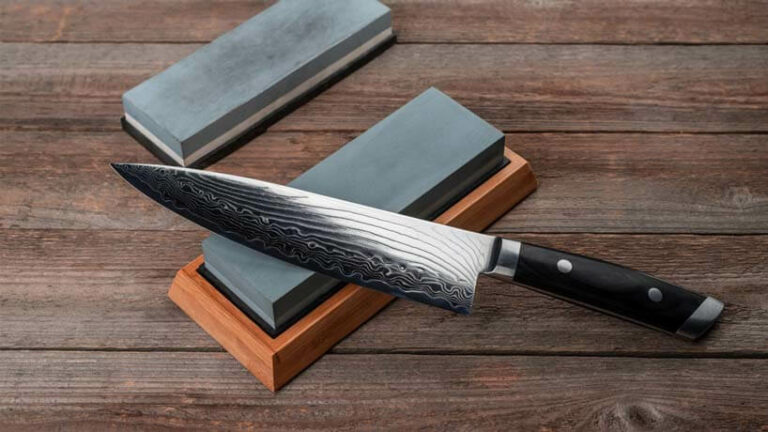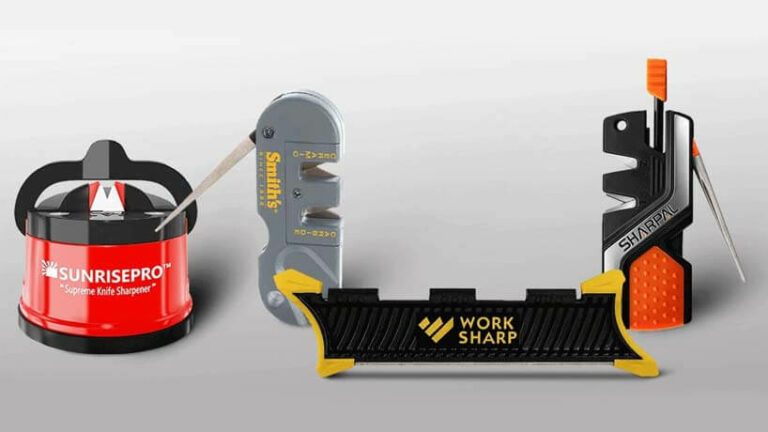Rusting is one of the most frustrating and common ways to render a great knife useless. It’s unsightly, ruins the performance, and can be dangerous. Knowing how to get rust off a knife helps to keep your knife in tip-top shape. Rust spreads like wildfire when left unchecked and can attack even the finest knives and steel.
Luckily, there are easy-to-follow steps you can do at home without needing to send the knife to an expensive repair shop. Perhaps you’ve just gone into the spider-ridden shed for the first time in years and dug up an old machete – or maybe your favorite chef knife is showing minor signs of rusting and you don’t know what to do.
Whatever your reasons, we’ll give you the information and know-how to get the rust off and have your knife looking and performing like it’s brand new. You’re going to find out about the common rust removal methods, why and how knives rust, and some tips to improve your care and maintenance routine.
By the time we’re done here, you’ll be ready to whip out a couple of household materials, and know exactly how to remove rust from a knife! Let’s take a look!
What Is Rust?

If you’re just looking for the methods to remove rust, feel free to skip ahead and jump straight to how to restore a rusty knife. Here we’re going to discuss what rust is from a technical point of view. It helps to know what you’re fighting against, and why the solutions work so well. Don’t worry though, this isn’t going to be a boring science lecture – we’ll be as brief and simple as possible.
Rust is the result of iron and oxygen reacting with moisture. This moisture doesn’t need to be full drops or streams of water. In fact, rust can simply be triggered by moisture in the air. If you live in a humid environment or coastal area, your knives are unfortunately more prone to rust and corrosion than other drier areas.
Rust is the name we commonly use for the chemical compound formed after the reaction takes place – called “iron oxide”. To be clear, it is that flaky brown-colored substance that slowly engulfs your knife if left unchecked. Let’s take a look at what kind of situations are perfect for rust to form.
Why Do Knives Rust?
As we now know, rust is the result of iron and oxygen reacting with moisture. If you live in a humid environment or coastal area, there’s more moisture in the air – which makes your knives more likely to rust. But what about my “stainless steel knives“, you ask?
Sorry to be the bearer of bad news, but steel has iron and iron rusts. Unless your knife is made from mostly chromium (Spyderco Salt Knife Series), you’re still going to be susceptible to corrosion. If you use your knife and don’t wipe and clean the blade afterward, it will start to rust.
The rust patch is normally very small but spreads rapidly. Similarly, storing your knives near other rust-infected and in a humid cupboard is almost guaranteed to invite them to the rusty club. Poor care and maintenance also play an important part in how susceptible and quick your knife rusts.
What Is Rust-Resistance?
Rust-resistance is just what the name implies – it involves resistance, not rust-proofing. No steel knives are rust-less. Including elements like chromium improves how well the knife resists corrosion and how well it fights its spreading.
Many knives, especially pocket knives, come with a rust-resistant coating to complement the steel’s decent resistance. This is particularly important for outdoor knives as you won’t have to clean rust off the knife as often. Now we’re going to take a look at 3 of the most effective home-rust removal remedies. Let’s take a look.
How to Remove Rust from a Knife Blade at Home

Here are 3 awesome home remedies for rust-removal you can use right now. They have minimal material requirements and are so easy you can do them yourself. Be mindful of safety, use cut-resistant gloves if you have, and don’t work too fast. You should also take care to not use any abrasive materials directly on the blade’s cutting edge as it can ruin it. Let’s jump into the remedies!
Method 1: Baking Soda Paste
Here’s an incredibly effective method that’s cheap and easy. Here’s what you’ll need:
- Clean water
- Baking soda
- Spare toothbrush
- Pot scrubbing pad or steel wool for severe cases
The baking powder reacts with the rust and breaks it down, and that’s all you need to know for now. It’s super-safe as long as you keep it out of your eyes. Once you’ve gathered all the above, move onto the steps. Remember to work your way through them slowly, especially if this is your first time – and don’t use steel wool directly on your knife’s cutting edge.
Make the Paste
Put a decent amount of baking soda into a mixing container. Add room temperature clean water a little at a time while mixing with a spoon or fork. Keep mixing and adding water as necessary until you have a baking soda paste. It shouldn’t be too thick (like playdough) or too thin (where it all runs off the knife-like milk).
Apply the Paste
Once you’re happy with the viscosity, lather the paste generously over the rust-infected areas of your knife. Make sure you get it up in all the little nooks and crannies where the rust is hiding or it will spread out again after a day or two.
Scrub Away
If the rust is mild to medium strength, a strong bristle toothbrush will be enough to clean rust off the knife. Scrub in small circular motions until you see the rust coming off. Do this for a couple of minutes. Repeat and re-lather the paste on troublesome areas.
Use a Tougher Scrubber for Difficult Spots
If some portions are particularly bad, use one of those green plastic pot scrubbers or the scrubbing part of a sponge. If the rust is very tough you can use steel wool. Be careful not to scrub too hard or to make contact with the cutting edge – or you’ll damage the knife finish and performance.
Method 2: Vinegar Soak and Wipe
This method is very simple and straightforward. You’ll need the following:
- Vinegar (preferably white vinegar)
- Container big enough to soak your knife in
- Some paper/fabric towels to wipe the blade down with
- Scrubbing sponge
Grab all your materials and let’s get started.
Pour the Vinegar into the Container
For faster results, you can heat the vinegar until it is warm (but not hot/boiling). You just need enough vinegar to cover the knife, so don’t worry about filling the whole container.
Soak the Knife
Submerge the knife in the vinegar. If your knife’s handle is made from wood, you might want to cling wrap it or just submerge the blade (and not the handle). Only leave the knife to soak in the vinegar for about 5-minutes. If you leave it in for much longer you’ll risk damaging the steel and the handle.
Wipe/Scrub the Knife
Remove the knife from the container and wipe it down with paper/microfiber towels. The rust should wipe away quite easily. If this method didn’t get rid of all the rust, you can use it in combination with method 1 for complete cleaning. Wash the knife with light soap and warm water then dry it thoroughly before storage.
Method 3: Sand and Pray
If you’ve just unearthed an old hatchet or have a knife that’s completely covered in rust, you’ll need to take a more physical approach to restore it. Note that this method shouldn’t be used with a small pocket knife and kitchen knives. It’s better suited to a large knife, large machetes, and hatchets. Secure the knife in a vice or on a table and get some 400-grit sandpaper.
Coarser sandpaper can ruin the blade’s finish. Sand over the affected area in small circular motions until you see the clean, fresh steel start to show. This takes quite a while, so be prepared for a bit of a workout. Make sure you keep the sandpaper safely away from the cutting edge or you’ll run the risk of dulling or damaging it.
Final Thoughts
Now that you know how to get rust off a knife, which method is right for you? Take the tips we’ve littered throughout the guide and get a little practice. Use what you have available to you or make a quick trip down to the local store and pick up the materials you’d need – they’re not expensive and get the job done well.
All that’s left for you now is to try out a couple of these methods and see which ones work best for you. Each knife and blade will have a method of rust removal that best suits it – take some time to find what’s perfect for you. Stay mindful of safety and don’t work too fast. You’ll have spotless blades that look and perform like new in no time!







